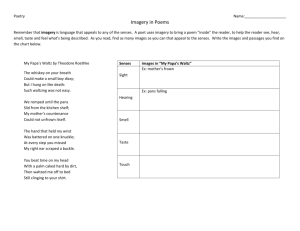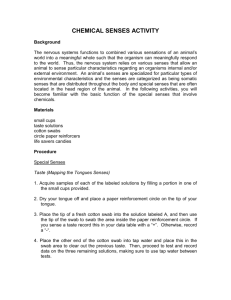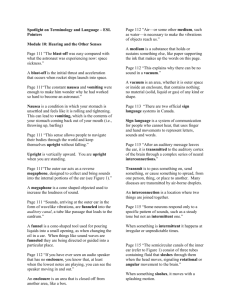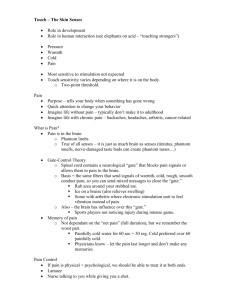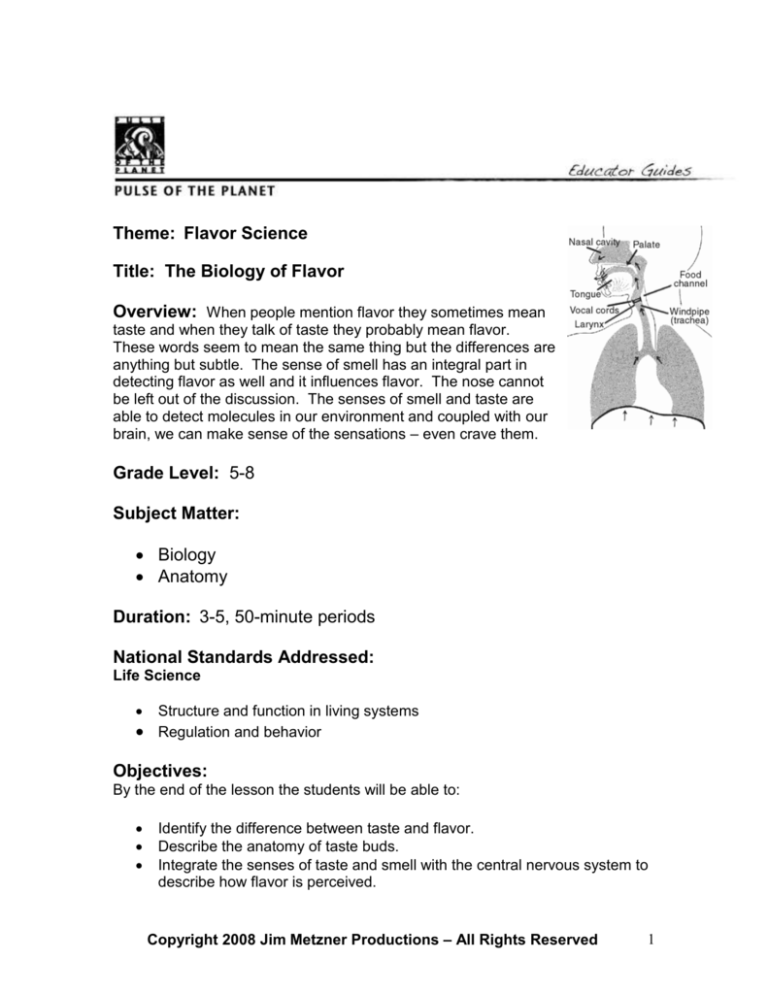
Theme: Flavor Science
Title: The Biology of Flavor
Overview: When people mention flavor they sometimes mean
taste and when they talk of taste they probably mean flavor.
These words seem to mean the same thing but the differences are
anything but subtle. The sense of smell has an integral part in
detecting flavor as well and it influences flavor. The nose cannot
be left out of the discussion. The senses of smell and taste are
able to detect molecules in our environment and coupled with our
brain, we can make sense of the sensations – even crave them.
Grade Level: 5-8
Subject Matter:
Biology
Anatomy
Duration: 3-5, 50-minute periods
National Standards Addressed:
Life Science
Structure and function in living systems
Regulation and behavior
Objectives:
By the end of the lesson the students will be able to:
Identify the difference between taste and flavor.
Describe the anatomy of taste buds.
Integrate the senses of taste and smell with the central nervous system to
describe how flavor is perceived.
Copyright 2008 Jim Metzner Productions – All Rights Reserved
1
Describe different smell and taste disorders.
Materials:
Computers
Internet access
Paper
Procedure:
1. Hook: Have students do the Life Savers experiment at the following
website:
http://www.exploratorium.edu/snacks/your_sense_of_taste/index.html
2. TASTE Mini-textbook
a. Start this portion of the lesson with a quick whiteboard activity.
i. Ask your students to define/describe what “taste” is.
ii. Have each small group present to the class their perception
of taste.
iii. For help access the following website
http://www.tastescience.com/abouttaste1.html
iv. Discuss/explain what taste vs. flavor is.
b. Pass out the document entitled “The Biology of Flavor Textbook
Project.”
c. Go over the contents of this handout. Entertain all questions.
d. Establish dates in which portions of the project are due.
e. Distribute the study guide.
i. Each group should receive at least on study guide packet.
ii. Be sure to provide copies of the Pulse of the Planet
programs to the students.
f. Binding:
i. Offer to bind the books if your school has the equipment.
ii. Optional: make binding a requirement. After all, it is a
textbook.
g. Evaluate the projects
3. Final Activity
a. Allow your students to have some fun with flavor, taste, and smell.
b. Print off the lab at the following site:
http://www.coralspringsmiddleschool.net/bronstein/Site_4/Ch9Class
ification_files/jellybeankey.pdf
c. Be sure to review how to follow a dichotomous key.
Copyright 2008 Jim Metzner Productions – All Rights Reserved
2
Handouts:
The Biology of Flavor Textbook Project
Objective: Your group will create a small textbook on the
biological aspects of flavor.
Procedure:
1. Complete the study guide to help you learn about the biological
factions of flavor perception.
2. Make sure you know all the due-dates to receive credit for the
completed portions of the study guide.
3. Compose a small textbook that explains how we as humans
identify flavors.
Textbook Contents:
Note: the project was set up so that the study and contents of the
book should work hand-in-hand. In other words, the study guide
mimics the contents of the book.
Taste and Flavor
The human tongue and taste
The nose
Taste, Smell, and Nerve Interactions
Taste and Smell Disorders
Reference page
Textbook Guidelines:
Your textbook must:
Have the dimensions of a folded (short-ways) piece of typing
paper (8.5” x 11”).
Be typed or handwritten using pen.
Contain drawings that explain your content.
o The drawings can be copied and pasted from the internet.
o Be labeled with figure numbers. For example, Figure 1,
Figure 2 etc.
Have a title page.
Have a table of contents. The study guide and the contents of
the book are one in the same. The table of contents of the
Copyright 2008 Jim Metzner Productions – All Rights Reserved
3
book should be generated from the main ideas in the study
guide.
Have a “Works Cited,” Bibliography etc. page. Follow MLA
style on referencing websites. Your teacher will guide you on
the best method for this.
There is no limit to the length of your book. However, there
must be at least on full page (front to back) dedicated to each
item in the table of contents.
The Biology of Flavor Study Guide
This study guide will help you to understand how we as humans
identify flavors. The better you answer the questions, the better
you will understand the material for your textbook.
Answer each question on this study guide. There is a reference letter
in parentheses after each question. This letter refers to a reference
listed below.
Chapter 1: What is Taste? What is Flavor?
The first chapter in your mini-textbook will be on taste and flavor.
Each question below must be written about in the first chapter of your
textbook. You may use pictures in your textbook (drawn or copy and
pasted) to help describe the contents of this chapter.
1. What is taste? (A, B)
2. Explain why ‘flavor’ is really meant when the word ‘taste’ is
often used to describe food. (B)
3. There are five tastes that scientists have found? Name and
describe them. (D, F)
4. What is umami? (D)
5. What are the two chemical senses? (C)
6. Why are they called “chemical senses?” (C)
Copyright 2008 Jim Metzner Productions – All Rights Reserved
4
7. What is the purpose of taste? (C, E)
What is Taste? What is Flavor? References
A. http://www.aip.org/dbis/stories/2006/15178.html
B. http://www.sinus-center.net/Smell-and-taste.html
C. http://www.cf.ac.uk/biosi/staffinfo/jacob/teaching/sensory/olfact1
.html
D. http://health.howstuffworks.com/taste2.htm
E. http://www.cf.ac.uk/biosi/staffinfo/jacob/teaching/sensory/taste.
html
F. http://www.livescience.com/health/060829_bad_tongue.html
Chapter 2: Taste and the Tongue
The second chapter in your mini-textbook will be on the
anatomy of the tongue. Each question below must be written
about in the second chapter of your textbook. You may use
pictures in your textbook (drawn or copy and pasted) to help
describe the contents of this chapter.
1. What does the term gustatory mean?
2. What are some functions of the tongue? (B)
3. Name two places that taste buds are found. (A)
4. The bumps on your tongue are not really taste buds, what are
they called? (A, B,)
5. What are the purposes of papillae? (B)
6. So, where are taste buds? (B, C)
7. Draw the anatomy of a taste bud. (C scroll down to “Taste Bud
Anatomy”
8. How many taste buds does an average adult have? (D)
Copyright 2008 Jim Metzner Productions – All Rights Reserved
5
9. How many taste cells are in a single taste bud? (D)
10. How many taste cells are in an adult’s mouth? (D)
11. Describe how the tongue interacts and captures flavor
molecules from the environment. Keep the explanation simple
(B)
12. Scientists have found that the “Tongue Taste Map” that you see
in reference “E” is no longer correct. They have found that you
can taste things all over your tongue. How is this possible? (G,
H)
13. Interesting: The universities of Purdue and Michigan both
attempted to answer the question: “How many licks does it
take to get to the tootsie roll center of a Tootsie Pop?” How
many? (B)
14. What is retronasal aroma? (I)
15. How does retronasal aroma link the mouth and the nose? (I)
16. Look up what “volatile” means and write down its definition. (I,
J)
17. How can you temporarily decrease your sense of taste? (Hint:
nose)? (J)
Taste and the Tongue References
A. http://www.tastescience.com/abouttaste2.html
B. http://health.howstuffworks.com/tongue2.htm
C. http://biology.about.com/library/organs/blpathodigest2.htm
D. http://www.aip.org/dbis/stories/2006/15178.html
E. http://www.unmc.edu/physiology/Mann/mann10.html
F. http://faculty.washington.edu/chudler/tasty.html
G. http://www.livescience.com/health/060829_bad_tongue.html
H. http://www.bulkmsm.com/AyurvedicHerbalMSM/p51.htm
I. http://biology.about.com/library/organs/blpathodigest2.htm
J. Pulse of the Planet program #1202: “Artificial Mouth”
Copyright 2008 Jim Metzner Productions – All Rights Reserved
6
K. Pulse of the Planet program #1203: “Artificial Mouth: Fat-Free
Flavor”
Chapter 3: The Nose
The third chapter in your mini-textbook will be on the anatomy of
the nose. Each question below must be written about in the
third chapter of your textbook. You may use pictures in your
textbook (drawn or copy and pasted) to help describe the
contents of this chapter.
1. What is the olfactory system? (C)
2. Draw a picture of the human olfactory system. Label the
following: olfactory epithelium, olfactory bulb, olfactory
neurons, cilia. (B, C)
The Nose References
A. http://biology.about.com/library/organs/blpathodigest2.htm
B. http://www.cf.ac.uk/biosi/staffinfo/jacob/teaching/sensory/olfact1
.html
C. http://www.sfn.org/index.cfm?pagename=brainBriefings_smellA
ndTheOlfactorySystem
Chapter 4: Taste, Smell, and Nerve Combination
The fourth chapter in your mini-textbook will describe how taste,
smell, and your nervous system all work together. Each
question below must be written about in the fourth chapter of
your textbook. You may use pictures in your textbook (drawn or
copy and pasted) to help describe the contents of this chapter.
1. What are the two components of “flavor?” (C)
2. Describe how taste, smell, and the brain all play into “flavor.”
(C,D)
Copyright 2008 Jim Metzner Productions – All Rights Reserved
7
3. Name the two nerves that are responsible for taste perception?
(F)
4. What parts of the tongue do the two nerves serve? (F)
5. What does the trigeminal nerve detect? (F)
6. What parts of the brain are responsible for flavor perception?
(F)
7. If the sense of smell is blocked, often the sense of taste is
diminished. When would this happen to you? (G)
8. What are chemoreceptors? Does the sense of taste and the
sense of smell both use chemoreceptors.?(E)
9. When you chew food, it releases air laced with chemicals. This
air goes up the back passage of your mouth into your nose.
How does this link the sense of taste and smell. (H)
10. How is the artificial mouth developed by Deborah Roberts
furthering our understanding of flavor through the combination
of taste and smell? (H)
11. How do fat-free foods differ from regular foods? How does this
affect the flavor of fat-free foods? (I)
Taste, Smell and Nerve Combination References:
A. http://biology.about.com/library/organs/blpathodigest2.htm
B. http://www.cf.ac.uk/biosi/staffinfo/jacob/teaching/sensory/taste.
html
C. http://health.howstuffworks.com/taste.htm
D. http://www.sinus-center.net/Smell-and-taste.html
E. http://health.howstuffworks.com/taste1.htm
F. http://faculty.washington.edu/chudler/tasty.html
G. http://faculty.washington.edu/chudler/nosek.html
H. Pulse of the Planet Program #1202: “THE ARTIFICIAL
MOUTH.”
Copyright 2008 Jim Metzner Productions – All Rights Reserved
8
I. Pulse of the Planet Program #1203: “THE ARTIFICIAL
MOUTH – Fat Free Flavor.”
J. Pulse of the Planet Program #1204: “THE ARTIFICIAL
MOUTH – Formulating Flavor
Chapter 5: Smell and Taste Disorders
The fifth chapter in your mini-textbook will briefly mention a few
smell and taste disorders. Each question below must be written
about in the fifth chapter of your textbook. You may use
pictures in your textbook (drawn or copy and pasted) to help
describe the contents of this chapter.
1. What are the two most common chemosensory disorders?
Describe them. (A,B)
2. What is hyposmia? (A,B)
3. What is hypogeusia? (A,B)
4. What are the dangers of smell disorders? (A,B)
5. What can cause smell and taste disorders? (A,B)
6. How are smell and taste disorders diagnosed? (A,B)
7. How are smell and taste disorders treated? (A,B)
Smell and Taste Disorders Research
A. http://www.healthsystem.virginia.edu/uvahealth/adult_ent/smell.
cfm
B. http://www.uchospitals.edu/online-library/content=P00466
Scroll down for more…
Copyright 2008 Jim Metzner Productions – All Rights Reserved
9
Additional Resources
Web Sites
The Science of Cooking – Exploratorium.edu
http://www.exploratorium.edu/cooking/
Interactions in Flavor – Ohio State University
http://www.tastingscience.info/Explained/Sensory.htm
Tasting Science – Ohio State University
http://www.tastingscience.info/abstracts.htm#Perceived%20Flavor
How Taste and Smell Interact? – Sinus Surgery Center / American British
Cowdray Medical Center
http://www.sinus-center.net/Smell-and-taste.html
Story of Discovery Archives: Smell and Taste – National Institute on Deafness
and Other Communication Disorders
http://www.nidcd.nih.gov/research/stories/archive_smell.asp
The Brain and Senses: Making Connections – The University of Manchester
http://www.childrensuniversity.manchester.ac.uk/interactives/science/brainandse
nses/connections.asp
Explore the Nervous System – University of Washington
http://faculty.washington.edu/chudler/introb.html#sense
Seeing, Hearing and Smelling the World – Howard Hughes Institute
http://www.hhmi.org/senses/
Smell (Olfaction) – Cardiff University
http://www.cf.ac.uk/biosi/staffinfo/jacob/teaching/sensory/olfact1.html
Pheromones – Society for Neuroscience
http://www.sfn.org/index.cfm?pagename=brainBriefings_pheromones
Taste Intensity – Society for Neuroscience
http://www.sfn.org/index.cfm?pagename=brainBriefings_tasteIntensity
Taste Detectors – Society for Neuroscience
http://www.sfn.org/index.cfm?pagename=brainBriefings_tasteDetectors
Physiology of Taste – About.com
http://biology.about.com/library/organs/blpathodigest2.htm
Copyright 2008 Jim Metzner Productions – All Rights Reserved
10
How Taste Works – Howstuffworks.com
http://www.google.com/search?hl=en&sa=X&oi=spell&resnum=0&ct=result&cd=1
&q=how+taste+works&spell=1
The Tongue – Innerbody.com
http://www.innerbody.com/image/nerv12.html
Your Sense of Smell (see more topics in left column) – Thinkquest.org
http://library.thinkquest.org/3750/smell/smell.html
Smell: The Nose Knows – University of Washington
http://faculty.washington.edu/chudler/nosek.html
Video
“The Five Senses” – Howstuffworks.com / United Learning
http://videos.howstuffworks.com/hsw/19759-the-five-senses-video.htm
Science of Cooking Webcasts (various) – Exploratorium.edu
http://www.exploratorium.edu/cooking/webcasts/index.html
Interactive Graphics
The Brain and Senses: Making Connections – The University of Manchester
http://www.childrensuniversity.manchester.ac.uk/interactives/science/brainandse
nses/connections.asp
Foodlab (interactive games, activities) – Meatandeducation.com
http://www.bmesonline.org.uk/resources/foodlab/foodlab.html
Articles
“Umami Taste Receptor Identified” (02/00) – Nature.com
http://www.nature.com/neuro/press_release/nn0200.html
“Human Nose Can ‘Smell Danger’” – The Telegraph
http://www.telegraph.co.uk/earth/main.jhtml?xml=/earth/2008/03/27/scismell127.x
ml
“Enhancing Taste: How It Works” (7/21/08) – Scientific American
http://www.sciam.com/article.cfm?id=enhancing-taste-how-it-works
Copyright 2008 Jim Metzner Productions – All Rights Reserved
11
“The Science Behind How We Taste” – MedicineNet.com
http://www.medicinenet.com/script/main/art.asp?articlekey=50541
“Yes, MSG, the Secret Behind the Savor” (3/5/08) – New York Times
http://www.nytimes.com/2008/03/05/dining/05glute.html?_r=2&oref=slogin&oref=
slogin
Just For Kids
What’s That Smell? The Nose Knows – Kidshealth.org
http://kidshealth.org/kid/body/nose_SW.html
Your Sense of Smell – Discover Kids
http://yucky.discovery.com/noflash/body/pg000150.html
Your Skin – Kidshealth.org
http://kidshealth.org/kid/htbw/skin.html
Your Tongue – Kidshealth.org
http://kidshealth.org/kid/htbw/tongue.html
It’s a Tongue! – Kidshealth.org
http://kidshealth.org/kid/misc/microscopic_tongue.html
Other
The Brain and Senses: Taste (diagram) – University of Manchester
http://www.childrensuniversity.manchester.ac.uk/interactives/science/brainandse
nses/discovermore/tongue.pdf
Your Sense of Taste (experiment) – Exploratorium.edu
http://www.exploratorium.edu/snacks/your_sense_of_taste/index.html
No Flavor Without Saliva (experiment) – Kidshealth.org
http://kidshealth.org/kid/closet/experiments/experiment_saliva.html
Food Science Activity Guide – Institute of Food Technologists
http://members.ift.org/IFT/Education/EduResources/IFT+Activity+Guide.htm
Science Snacks: Perception (activities re: perception) – Exploratorium.edu
http://www.exploratorium.edu/snacks/iconperception.html
Copyright 2008 Jim Metzner Productions – All Rights Reserved
12
Photos and Graphics
Name: The Human Nervous System
URL:
http://upload.wikimedia.org/wikipedia/commons/b/ba/Nervous_system_diagram.p
ng
Caption: The human nervous system.
Credit: Persian Poet Gal
Name: Taste Bud
URL: http://en.wikipedia.org/wiki/Image:Taste_bud.svg
Caption: Schematic drawing of a taste bud.
Credit: Neuro Tiker GNU
Human Senses Pictures (slideshow) – Howstuffworks.com
http://health.howstuffworks.com/human-senses-pictures1.htm
Taste-Receptor Cells, Buds and Papillae – Nature.com
http://www.nature.com/nature/journal/v444/n7117/fig_tab/nature05401_F1.html
Special thanks to the following scientists for their help with this project:
Pulse of the Planet Programs: #1202 “Artificial Mouth,” #1203 “Artificial Mouth:
Fat-Free Flavor,” #1204 “Artificial Mouth: Formulating Flavor”
Deborah Roberts
Food and Flavor Scientist
Food and Flavor Science Consulting LLC
Header Image
Name: Gustatory System
Credit: NIH
Copyright 2008 Jim Metzner Productions – All Rights Reserved
13



